In early March, many of us were probably asking ourselves a similar question: “How do I keep producing art and growing while in the midst of a pandemic?” I’ll be sharing a bit about how I answered this question and I hope it will be helpful.
In January I set a personal goal to paint at least 80% from life, and if I could achieve 100% that would be even better! Due to a recent surgery and other issues, standing for any length of time at an easel or walking uneven terrain is difficult, and we now had a ‘lock down’ in Ohio. I decided that painting still life works would be a great way to meet my goals, keep my skills sharp, and also create something meaningful…not to mention keep my mind occupied and anxiety in check!
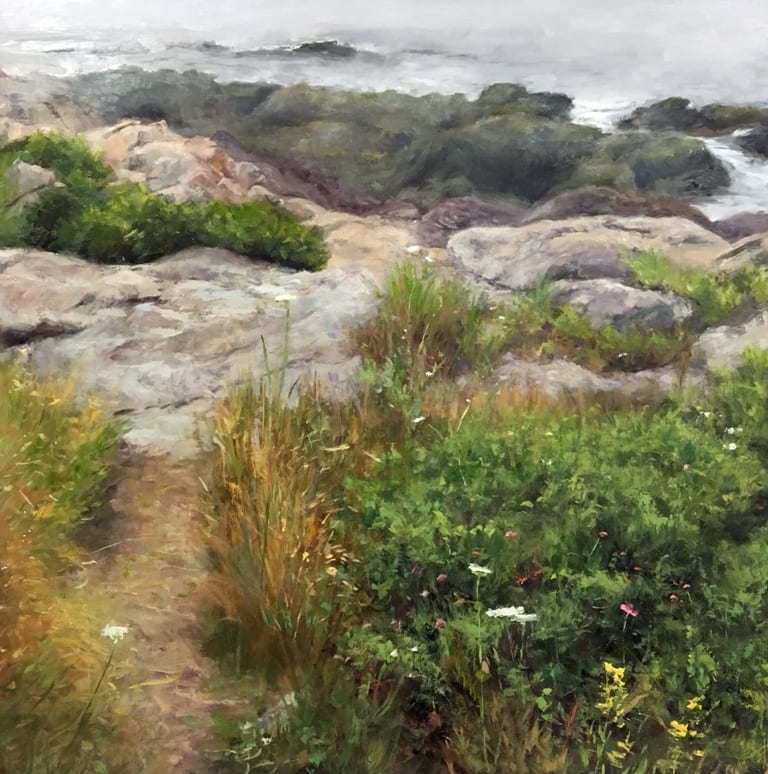
24″ x 24″ – Oil
Having been a landscape painter almost exclusively for most of my life and with no formal art school training, I felt like a fish out of water when it came to still life. I kept seeing inspiring posts about learning to paint still life from my friend, Kelli Folsom OPA, so I decided to sign up for her ongoing course, Vital Art Sessions. My intent isn’t to endorse any particular course or artist, although I highly recommend Kelli, but I’m sharing what worked for me. Taking a course with an accomplished, inspiring, award-winning artist has been so beneficial, because it’s given me the structure and motivation I needed to keep on track. Having a private Facebook group where participants can share their “oops” was also beneficial. Because of my goal, painting mostly from life, I used the practice lessons to get better at painting objects correctly and then tried interpreting the lesson using my own props and, finally, creating my own setups.
As a point of information: I’m not selling the works copied from Kelli’s video lessons because they are not my original concept, but they are great learning tools. Many were clunkers, to be honest. I completed more than 50 paintings from the beginning of March through mid-June when I took the photo (below). As a former teacher, I know the importance of concrete learning experiences and celebrating our ‘wins’ when learning new skills, so actually seeing that body of work in one photo was really encouraging.
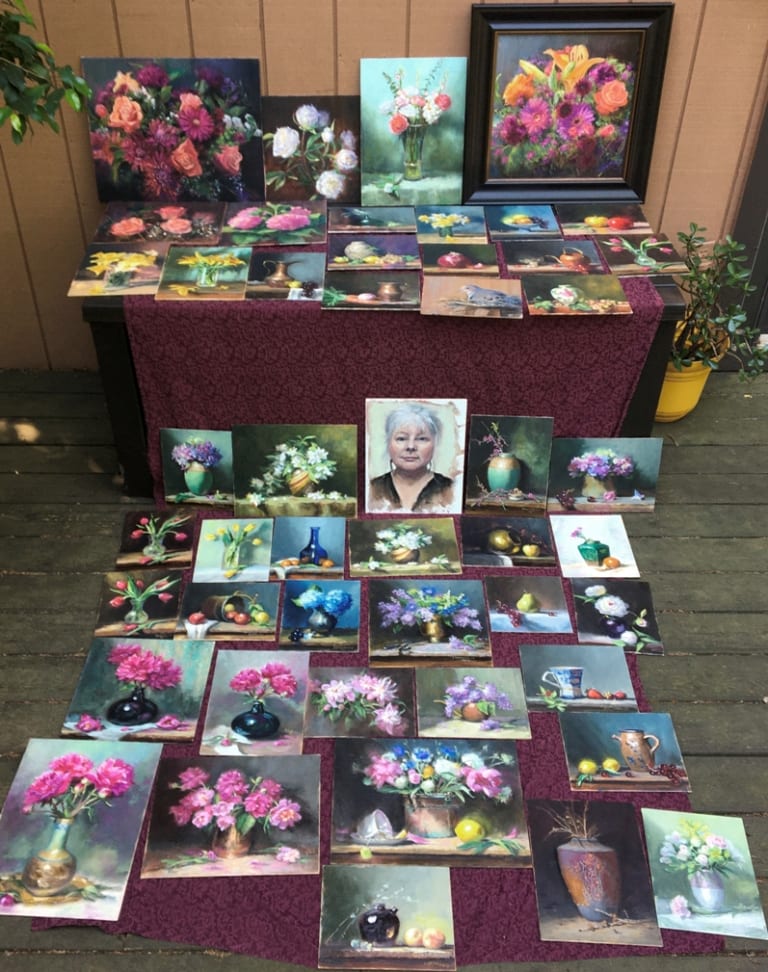
Painting is a very complex activity, and still life painting is no exception: our brain must interpret a 3-dimensional object/scene onto a 2-dimensional surface. It takes a lot of time to set up a successful still life, sometimes even longer than doing the actual painting! The artist is actually creating the setting, including the lighting, colors, shapes, and composition/concept, rather than responding to what is already there, as is the case with plein air painting. It requires a different set of problem-solving skills than when working outdoors, although there are similarities. Some questions you might ask: What colors will you use? Do you have a color plan? How will the eye move through the composition? What is your value plan? Do you have enough/too much variety in sizes? What size canvas? There are many considerations; these are but a few.

My studio is in the basement and the lighting was too harsh; I couldn’t see the shadows on the objects because of too many light sources, so that required changing my lighting. You need a light blocker and, ideally, a table that can move up or down so you can adjust the perspective on the setup. Some old, black mat board taped together made a great light blocker; stacked wooden boxes on top of an old side table made a stand. Later on, I found an inexpensive standing desk that has an adjustable lever so it can go up to 42” and bought the black trifold presentation cardboard for the light blocker. There are lots of free videos and tips on various ways to set up lights and create a light blocker if you do a google search.
The pandemic and inability to go out prompted some more problem solving…how do you get flowers, fruit, etc., when a quick trip to the grocery store isn’t possible? It’s the old adage: make do with what you have. It was very refreshing; few options = greater creativity. An old skirt with a Bohemian flavor became a great drape for the background. The redbud tree was resplendent this year, providing the inspiration for a painting using a complementary color scheme. Small branches from shrubs make great additions for scale/color, and when the wild cherry tree and lilac bush bloomed, they became the centerpiece of a few paintings. Learning something new causes one to look at things with new eyes….
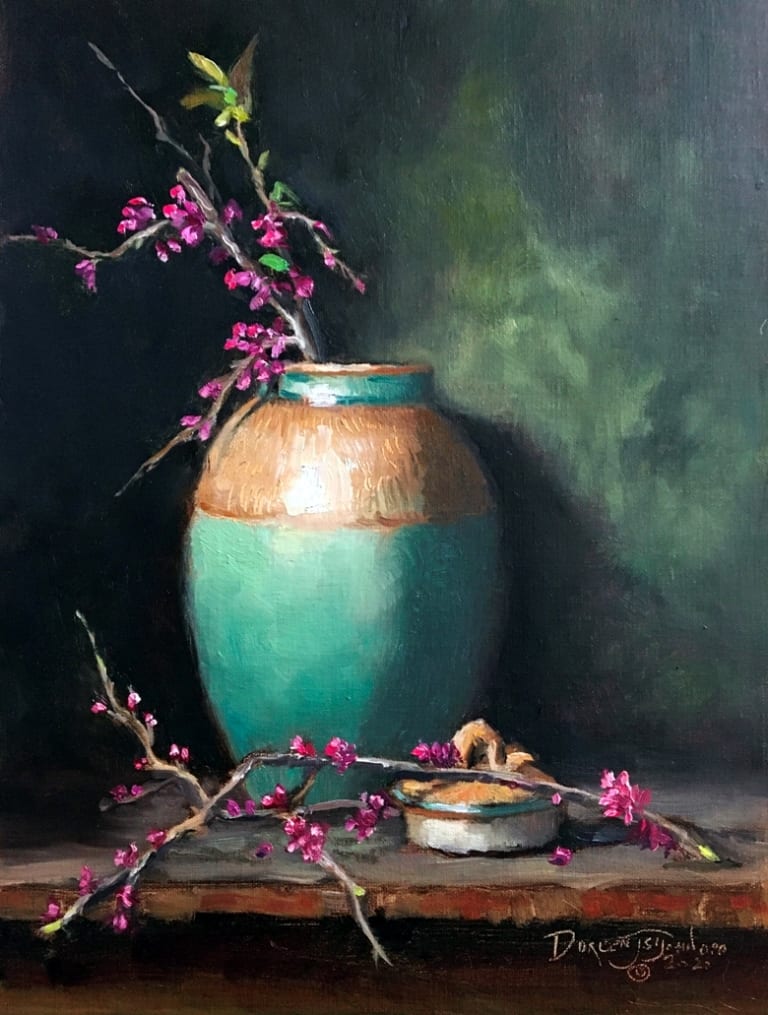
12″ x 9″- Oil
And then there are the props…! You need a wide variety of shapes, sizes, finishes, and textures to create an interesting still life, in addition to flowers, vegetables, and fruit. I’ve been given/collected some beautiful ceramic works over my lifetime (I’ll be 70 next month), and they are really special…gorgeous raku’, lovely glazes, interesting shapes/colors…and also inherited a few really old pieces full of history and memories. One of the most surprising and engaging aspects of still life painting has been recalling the memories of loved ones as I paint a favorite vase or even the history I can feel when thinking about those times. How can I get that emotion/connection into my paintings? Sometimes it just flows out of the brush if you are in the right frame of mind, but most of the time it requires more thought and planning.
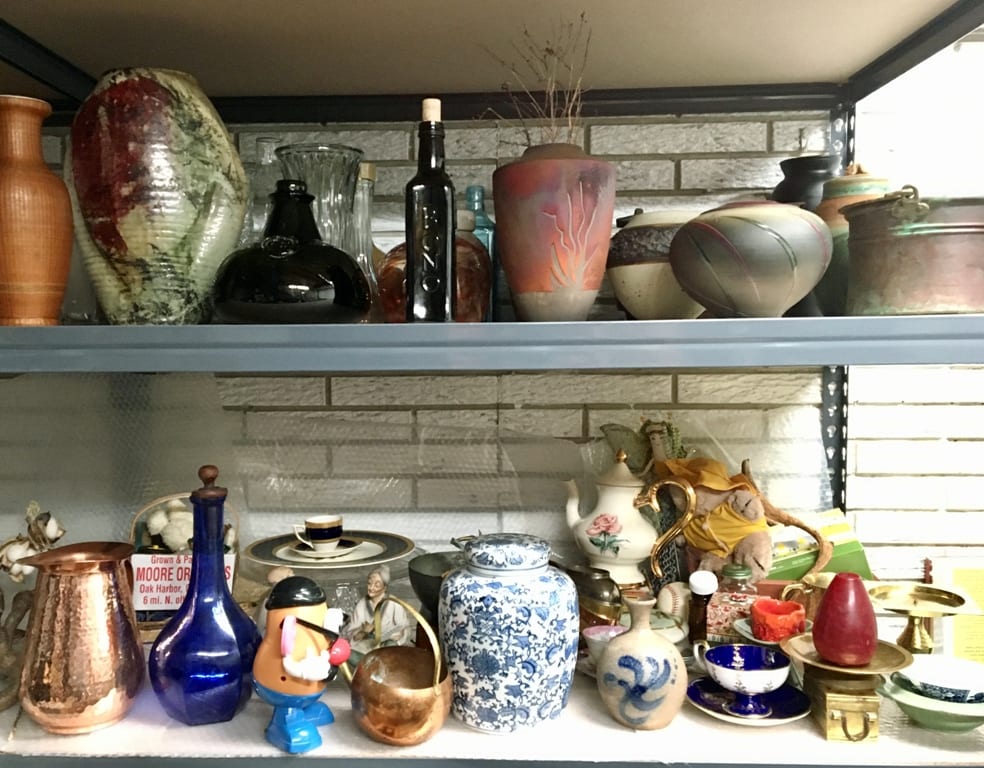
There is a lot of research about how people learn new skills, and one recommendation is that you need more easel time (practice). As a former teacher, I know that practice is important but it isn’t the only consideration when learning a new skill; you need focused practice as well as more contextual learning. Painting is a complex activity, and developing mastery with still life painting is more than being able to paint a great ellipse (something that can still challenge me!). Reading books on the topic, watching videos, and viewing works in person (art museums) or online by famous still life artists is also valuable. I took an online intensive 5-day still life workshop with Kelli, signed up for another online class with a nationally known artist, and have been doing a lot of reading/research, which is ongoing. A couple of books on still life were welcome additions to my collection of art books, and watching videos about still life painting over again with fresh eyes was enlightening. There are some great Zoom presentations and videos out there, and many are free, dealing with all kinds of art, so if you have an internet connection and a cell phone you are good to go! I have an Apple TV connection, so I will often mirror the YouTube video/Zoom presentation on my big screen TV.
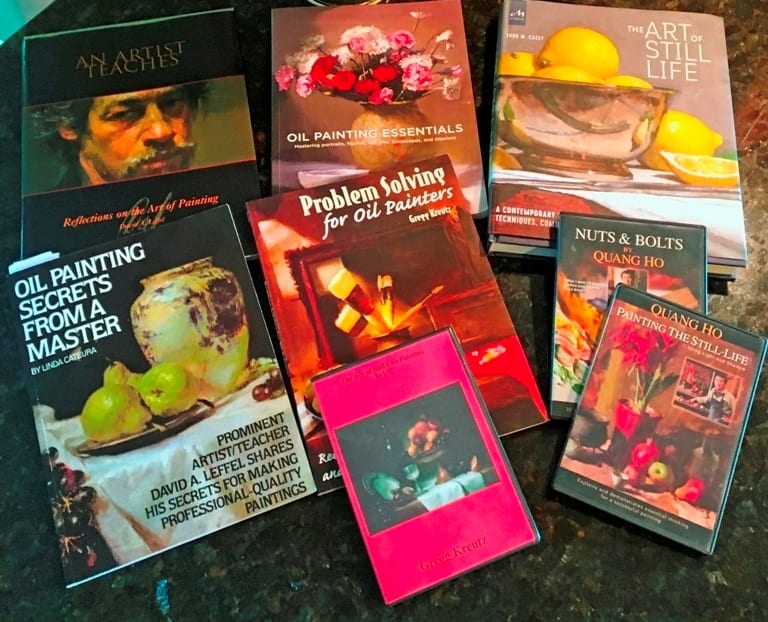
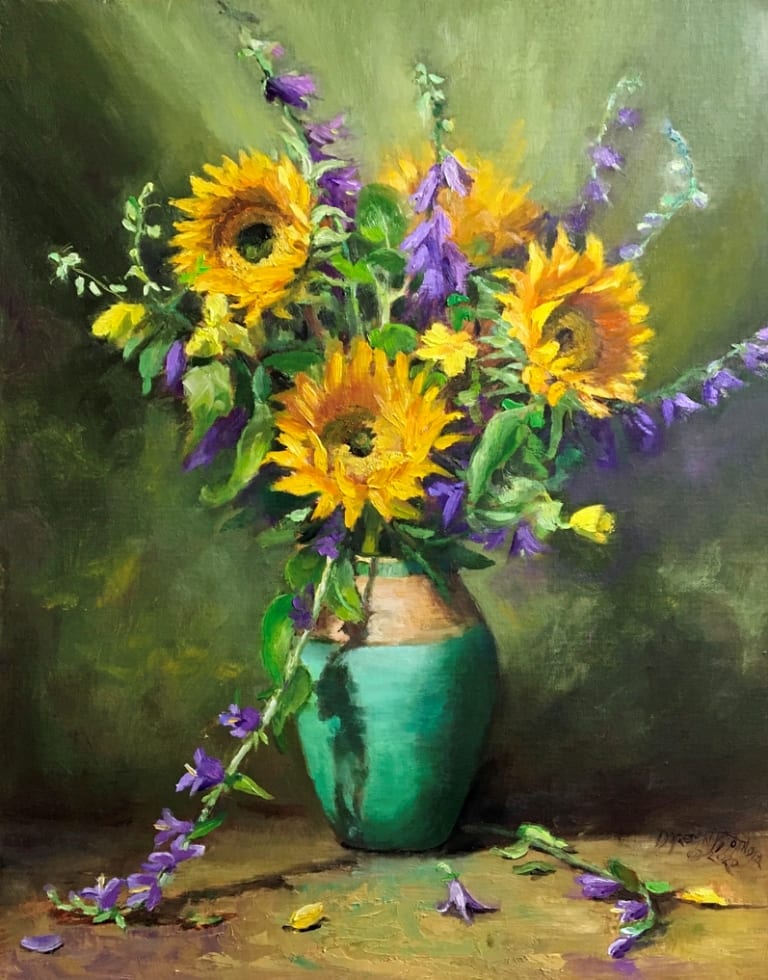
20″ x 16″ – Oil
By doing something productive I’ve felt better. It’s required me to suspend judgment, open my mind, and accept help/guidance, sometimes a very difficult thing for a professional artist at any age. Many of those old ‘rules’ and ideas need to take a back seat in order to learn something new. I find that using a slogan such as “Take what you like and leave the rest” is very helpful…as is “slow and steady wins the race”. It helps me to get out of my lock-step methods and opens me up to question/examine. My goal has always been to be a ‘lifelong learner’, and to improve as an artist, not to adopt another artist’s style but to dig deep and become more expressive, creating something that is heartfelt. It’s really caused me to think more about form, edges, about how light falls on an object, and to ask questions, such as, “What is my concept? Why do I love this? How can I get more emotion into my work? What if….”
On a happy ending note, I entered three still life paintings for the first time in the OPA Salon Show and just found out one was accepted, “Mother’s Day Bouquet”! I’m sharing my story not to brag, but to encourage others – at any age – to try that thing you’ve never tried. For me, it’s opened me up to new possibilities and new ways of thinking, not only about art, but about life. These are such difficult times right now. Because I worked full time in as an educator for more than 30 years, I kept telling myself I would paint once I retired. I’m so grateful I have the time to do this now. I keep praying my health will hang in there so I can continue to learn, paint, and grow. I’m wishing the same for all of you!
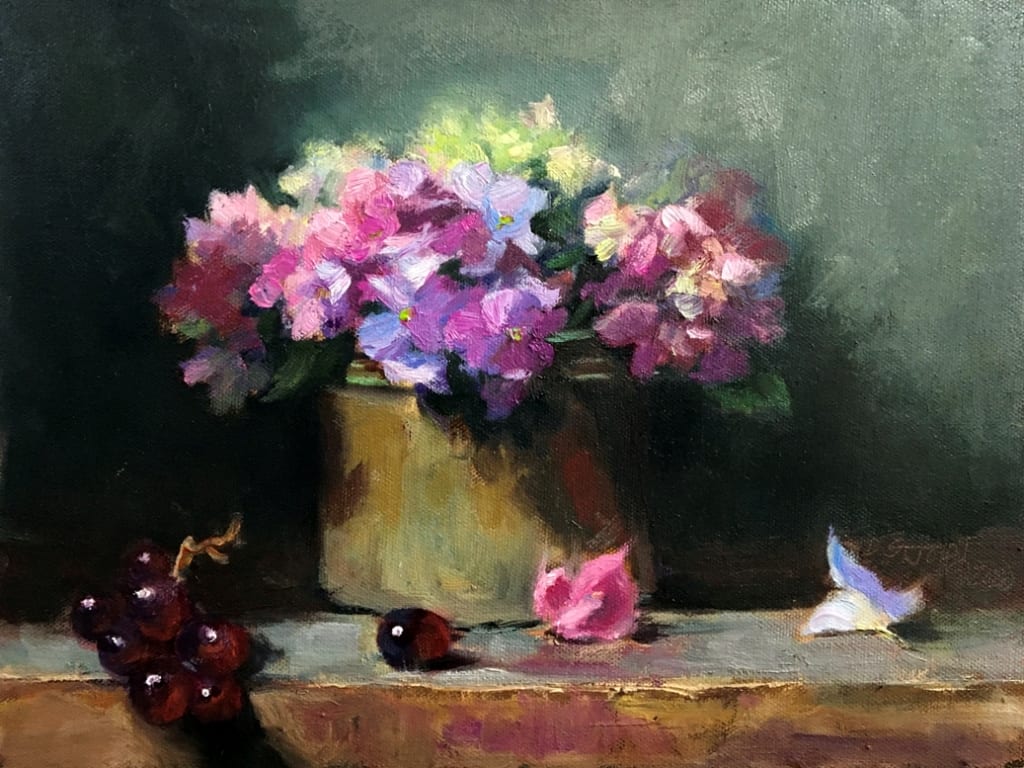
9″ x 12″ – Oil
Leave a Reply